In this spookily prescient booklet, people are advised to keep six feet apart, avoid shaking hands and only send one person per household out to do the shopping.
I
It was the dead of night in mid-November 1582. A sailor stepped onto the dock at the port of Alghero, Sardinia, and took in the view of the city for the last time.
The unfortunate mariner is thought to have arrived from Marseille, 447km (278 miles) across the Mediterranean Sea. The plague had been raging there for a year – and it seems that he had brought it with him. He was already delirious, and suffering from the characteristic swellings that marked out the disease, known as buboes, in his groin area.
And yet, somehow the sailor managed to get past the plague guardians, or Morbers, whose job it was to stop those who had any symptoms. He made it into the city. Within days, he was dead and an outbreak had begun.
At this point, many of the people of Alghero were already doomed. Based on official records from the time, one 18th-Century historian estimated that the epidemic led to 6,000 deaths, leaving only 150 people alive. In reality, it's thought that the epidemic killed 60% of the city's population. (The exaggeration may have been an attempt by the government of the time to avoid tax.) Mass graves sprung up, some of which remain to this day – long trenches filled with the bones of up to 30 people at a time.
You might also like:
It could have been worse, however. The surrounding districts were largely spared – unusually, the contagion remained in Alghero and vanished within eight months. It's thought this was all down to one man and his prescient conception of social distancing.
"It is perhaps a bit surprising to find this knowledgeable doctor in this rather parochial town," says Ole Benedictow, emeritus professor of history at the University of Oslo, who co-authored a paper on the subject. "You would expect for measures to be introduced more strictly in the big commercial towns, such as Pisa and Florence. But this doctor, he was in the front of his time. It's quite impressive."
Live chickens and urine
The most notorious plague episode in history was of course, The Black Death, which swept across Europe and Asia in 1346, killing an estimated 50 million people worldwide.
In Florence, the Italian poet Francesco Petrarca didn't think future generations would be able to grasp the scale of the devastation. He wrote: "O happy posterity, who will not experience such abysmal woe and will look upon our testimony as a fable." The remains of the plague's victims are regularly unearthed as part of tunnelling projects today, such as Crossrail in London. Records suggest that there are 50,000 bodies hidden under Farringdon alone.
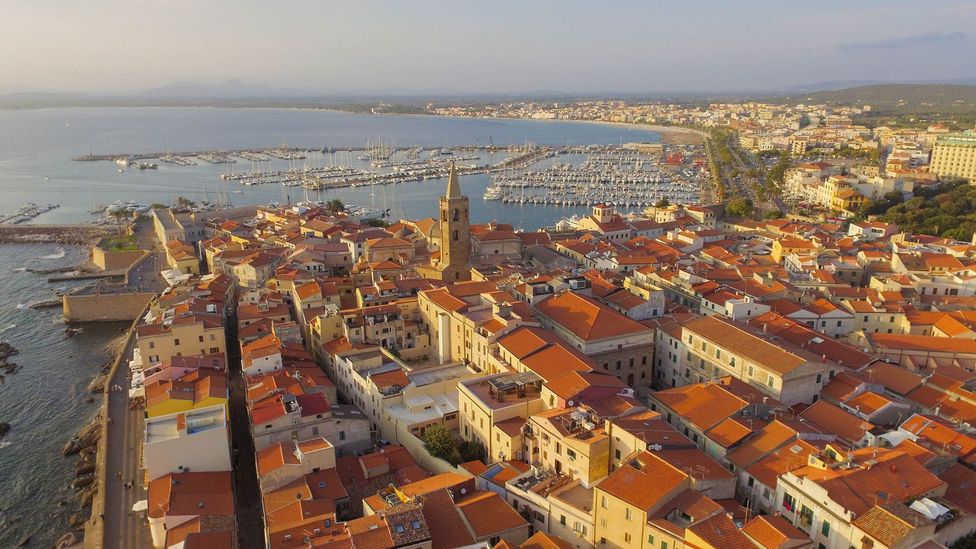
The medieval city of Alghero is now a popular holiday destination, but it was the epicentre of a devastating plague outbreak in 1582 (Credit: Milosz Galezowski/EyeEm/Getty Images)
But though the plague was never quite so catastrophic ever again, it remained a regular visitor in the coming centuries. It was reportedly present in Paris for one out of every three years until 1670, while in 1563 it's thought to have killed 24% of London's population.
This was a time before modern science, when the current understanding was that diseases were caused by "bad air" and vinegar was a cutting-edge antiseptic. Treatments for the plague ranged from the revolting, such as bathing in one's own urine, to the bizarre – one popular method was to attempt to draw the "poison" out of buboes by rubbing them with the rump of a live chicken.
Plague knowledge
As Benedictow and his co-authors explain, Alghero itself was not well-set-up for an epidemic. The city was burdened with poorly organised sanitary systems, a handful of badly-trained medics and a "backwards" medical culture. It had its work cut out.
Enter Quinto Tiberio Angelerio, a 50-something doctor – Protomedicus – from the upper classes. He had trained abroad, because there were no universities at the time in Sardinia. Luckily for the residents of Alghero, he was fresh from Sicily, which had endured a plague epidemic of its own in 1575.
Alghero's patient zero arrived with buboes and, later, two women died with distinctive bruises on their bodies – another feature of the disease. Angelerio knew immediately what was happening. His first instinct was to ask for permission to quarantine the patients, but he was thwarted again and again – first by indecisive magistrates, then by a senate which rejected his report and put his concerns down to apocalyptic visions.
Angelerio became desperate. "He had the courage or the guts to turn to the viceroy," says Benedictow. With their agreement, he set up a triple sanitary cordon around the city walls, to prevent any trading with people outside.
Initially, the measures were extremely unpopular, and the public wanted to lynch him. But as more people died, they came round – and he was fully entrusted with the task of containing the outbreak. Years later, he published a booklet, Ectypa Pestilentis Status Algheriae Sardiniae, detailing the 57 rules he had imposed upon the city. Here's what he did.
Lockdowns
First, citizens were advised not to leave their houses, or move from one to another. Along these lines, Angelerio also forbade all meetings, dances and entertainments – and stipulated that only one person per household should leave to do the shopping, a rule that should be familiar to many enduring pandemic restrictions today.
Lockdowns were not unique to Alghero. "In Florence, for example, they imposed a total quarantine of the city in the spring of 1631," says John Henderson, a professor of Italian Renaissance history at Birkbeck, University of London. And just as today, rule-breaking was common.
"Over the year from the summer of 1630 to the summer of 1631, I found something like about 550 different cases that people were prosecuted for, for various infringements of the public health regulations," says Henderson. For most of that time, the city wasn't in full lockdown, but people were expected to self-isolate for 40 days if a member of their household was suspected of having the plague, and taken to hospital. This is where the word "quarantine" comes from – "quaranta giorni" means "40 days" in Italian.
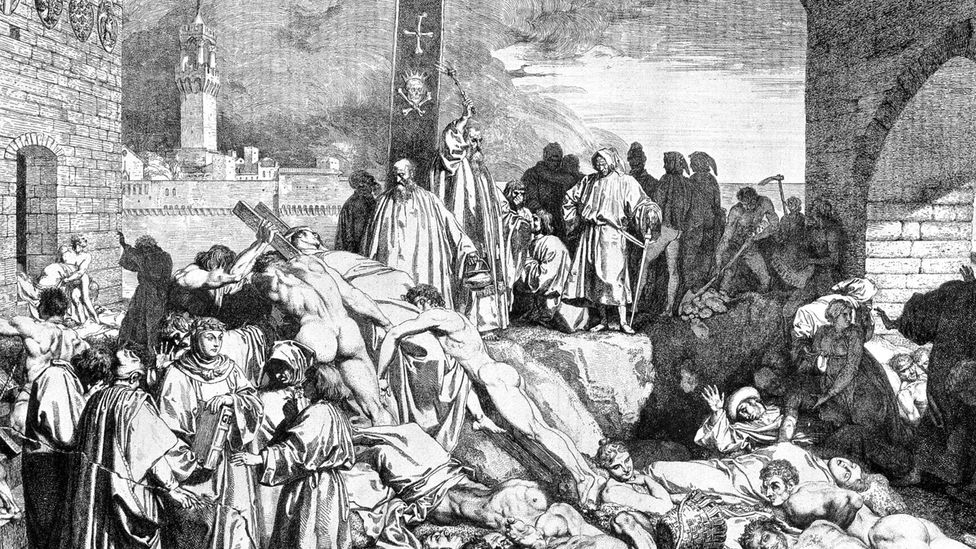
The plague spread most rapidly in cities, where it was transmitted via contact with fleas, infected tissues or droplets in the air (Credit: Pictorial Press/Alamy)
"Obviously people got impatient," says Henderson. In the days before smartphones, streaming services, or even affordable books, people innovated ways to get around the total boredom of being confined to the house. "And so the court cases provide an extraordinarily lively account of the type of reactions that people had when they were locked up," he says.
Sometimes people were just unlucky – in one example, a woman rushed out of the front door after her chicken, which had made a bid for freedom onto the street. "As she runs back having caught it, a member of the Health Board comes along and arrests her for breaking the plague regulations"," says Henderson. She was taken to prison, but soon released by a sympathetic judge who explained that her offence was very minor.
In another, a woman whose son lived in the apartment beneath sent a basket down to him, in which he placed a pair of socks that need repairing. Then she hauled it back up. "Then a Health Board officer comes along, having seen what she was doing, and takes her off to prison," says Henderson.
But other people are more culpable. "Some people climbed along the roofs on contiguous terraced houses, and met friends to play the guitar and drink together, again breaking the plague regulations against people mixing together from different households," he says.
Physical distancing
Next up was the six-foot-rule, in which Angelerio instructed that – as translated by Benedictow's team – "People allowed to go out must bear with them a cane measuring six feet long. It is mandatory that people keep this distance from one another."
Here Angelerio really marks himself out as an expert social distancer – none of the experts I spoke to had heard of this happening elsewhere. And yet, at the beginning of the Covid-19 pandemic, many countries around the world adopted an uncannily similar policy, recommending that people remain two metres (6.6ft) apart where possible.
In many places, including the UK, France, Singapore, South Korea and Germany, the minimum distance has since been reduced to one or one and a half metres. But it turns out the 16th-Century policy may have been on the right side of science: one study estimated that the risk of transmitting Covid-19 at one metre could be between two and 10 times higher than the risk at two metres.
And Angelerio went further. He also specified that a large rail, or parabonda, should be added to the counters at shops in which foods are sold, to encourage people to keep their distance – and recommended that, during mass, people should be careful when shaking hands.
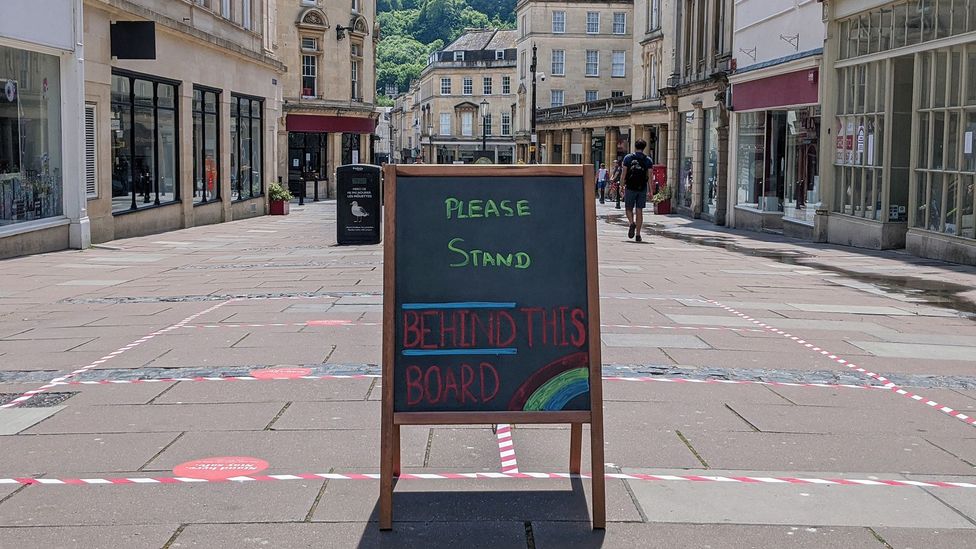
Many countries now require people to keep two metres apart at all times – roughly the same as that recommended in 16th-Century Sardinia (Credit: Jamie Lawton/Getty Images)
"I think he is more goal-oriented, with respect to the anti-epidemic measures that he wishes to introduce [than other doctors of his era]," says Benedictow. "I think it's mainly a question of degree and being early in his understanding of the required measures."
Washing your shopping
The Renaissance is popularly remembered as a golden age of classical philosophy, literature and especially art, when Michelangelo, Donatello, Raphael and Leonardo (da Vinci) – the Italian artists, not the ninja turtles – transformed their field with their genius. But it also ushered in great leaps forward in our scientific understanding.
This was when the physicist Nicholas Copernicus discovered that the Earth revolves around the Sun, rather than the other way around, and da Vinci drew up plans for making parachutes, helicopters, armoured vehicles, and an early robot. Then around 1500, leading thinkers built on the idea that diseases were caused by "bad air", to incorporate the possibility that people could become sick from touching objects that had been contaminated by this miasma.
"I see a connection between the development of the Renaissance and the ability of people in the 16th Century to understand more about how disease was spread," says Benedictow. "Angelerio understood that it was spread by contact and connection." One example is his stipulation that the owners of houses must disinfect, whitewash, ventilate and "water" them. He explained that any objects that aren't particularly valuable should be burned, while expensive furniture can be washed, exposed to the wind, or disinfected in an oven instead.
At the time, it was also common to disinfect goods as they arrived – especially those from ships. "One of the things that they thought was the most risky were textiles," says Alex Bamji, a social and cultural historian of early modern Europe from the University of Leeds. "But all sorts of things get disinfected, including letters," she says. Sometimes this leaves behind traces that can still be seen today. "If smoke and fire were used to disinfect them, you can still find the odd scorch mark here and there."
Health passports
One popular way to prevent the plague from turning up was to carefully check the health status of anyone who wanted to enter a city. Though the system failed at Alghero, where the 1582 outbreak's patient zero slipped past the guards stationed at the port, it was common elsewhere in Europe at the time.
In some cases, the authorities issued physical documents which enabled the bearer to pass through the gates despite any restrictions, either because they had been certified as plague-free or happened to know the right people.
"So, if you're a traveller, and you're going on business from one city to another – either your city has the plague or you're travelling to a city with the plague – you will need a health passport," says Philip Slavin, an associate professor of history at the University of Stirling.
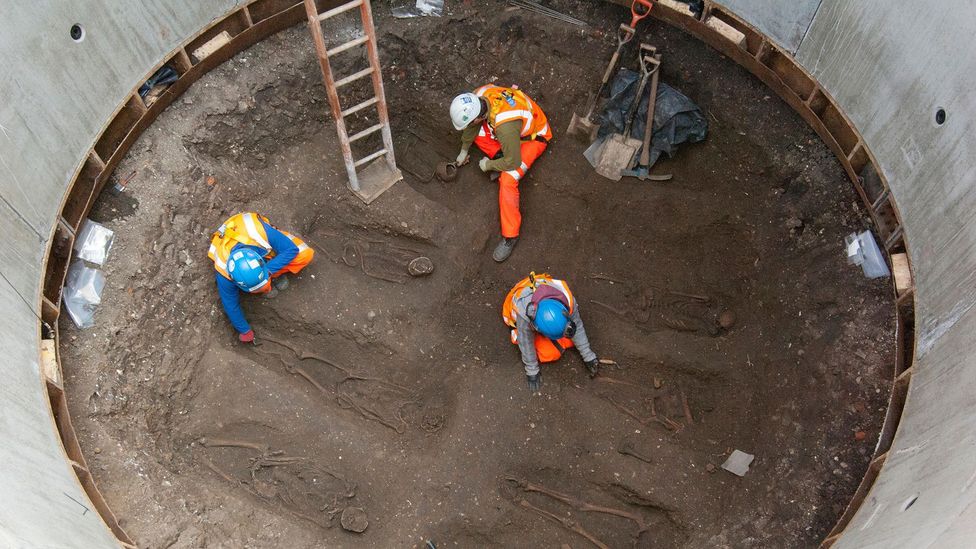
Archaeologists found traces of 660-year-old bacteria in the skeletons of plague victims unearthed by the Crossrail project in London (Credit: Amer Ghazzal/Alamy)
When the Covid-19 pandemic began, the concept of "health passports" was resurrected. Recently several international airports – including London, New York, Hong Kong and Singapore – have been trialling "CommonPass", a digital document that can display a user's test results and vaccination records. The idea is to easily confirm their infection status to make international travel safer and more efficient.
Intriguingly, though the Alghero epidemic occurred centuries before the scientific concept of immunity emerged, Angelerio also assigned certain tasks to those who had already acquired and survived the plague. He decreed that grave-diggers should be hired from among this group – a high-risk job because they were expected to transport confessional booths to the bedsides of dying patients, and, of course, deal with the bodies of the deceased.
Quarantine
Italy was an early pioneer of isolating people suspected of having the plague – and on a truly massive scale. The first plague hospital, or lazaretto, was set up in Venice in 1423 – and soon they had separate facilities for active patients versus those who were recovering or who had come into contact with someone who was infected. By 1576, the city had up to 8,000 people staying at the former, plus around 10,000 at the latter.
Eventually lazarettos became part of the standard model for dealing with the disease, and examples sprung up all over Italy, including Sardinia. They were part-hospital, part-prison – the quarantine facilities were usually mandatory, and in some circumstances patients were taken directly there by a city's plague guardians.
"They're not viewed positively – people at the time often described them as being 'like hell'," says Bamji, though she cautions that this may be more of a reflection of the stigma that surrounded them, than what they were really like.
"Huge amounts of money was spent on them – that's one thing to say," says Bamji. "And there's evidence that the food was pretty good." She explains that around half the people who stayed at lazarettos died, but of course the other half went home – and this is a comparable fatality rate to that seen in the rest of the population.
In Angelerio's account of the lazarettos in Alghero, they are remarkably well-ordered. The plague guardians were expected to keep track of everything brought into and out of the institutions, such as beds, furniture, and food. The poorest members of society were not expected to pay for their treatment. Sick patients were sometimes carried there from their homes, while orphaned babies who didn't have a wet nurse were bottle-fed with the milk of "well-fed goats", which were allowed to roam freely within its walls.
Dead cats
For all the similarities between the measures taken against outbreaks in the 16th Century and the kind we're familiar with today, there are some crucial differences.
In Renaissance Sardinia, superstition and religion were still key elements of Angelerio's epidemiological plans – he told the public that the plague was a divine punishment, and warned them to be on their best moral behaviour – and some of his instructions weren't just ineffective, they were baffling.
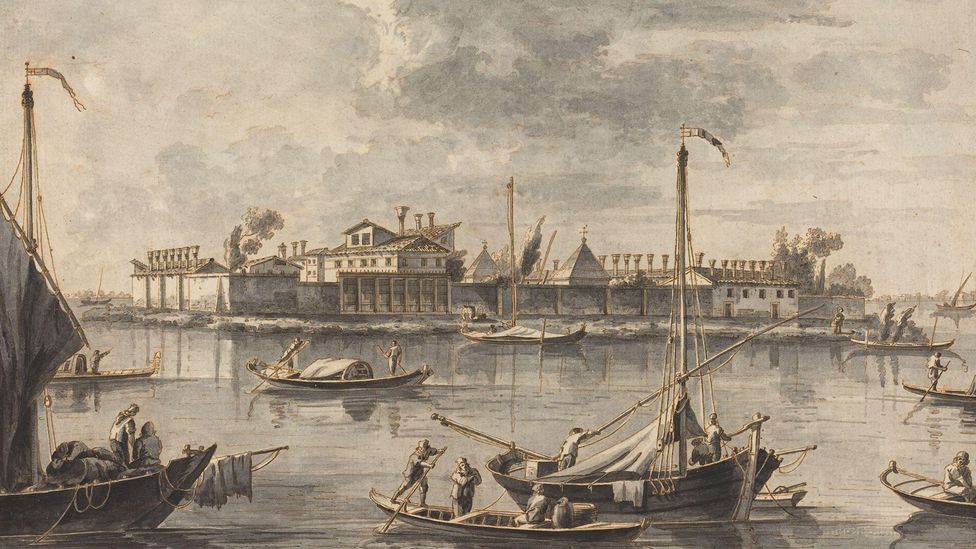
The Lazzaretto Nuovo was built on an island next to Venice in 1468, as a place to quarantine incoming ships and cargo (Credit: Alamy) (Credit: AlFA Visuals/Alamy)
One example is the instruction that "turkeys and cats must be killed and thrown in the sea". This was a surprisingly common reaction to an epidemic – the author Daniel Defoe reported that, during the 1665 plague in London, the mayor ordered the slaughter of 40,000 dogs and 200,000 cats – and special dog-killers were appointed for the task.
However, this mass-execution of the city's predators may have had the opposite effect to the one intended – since rats are known carriers of the plague. (Rats were also persecuted directly in some cities, but not mentioned in Angelerio's account.)
Fast-forward to 2020 and, though there is hard evidence that cats and dogs can become infected with Covid-19, they remain as beloved as ever – many pet charities have reported record numbers of adoptions in recent months, with a branch of the RSPCA in Australia reporting 20,000 applications since the start of the pandemic.
In Benedictow's view, comparisons between the plague and Covid-19 should be viewed with some scepticism. "Plague epidemics were much worse and had an almost inconceivable mortality rate," he says. "It was usual that 60% and even 70% of a town or district population lost their lives."
So what happened to the residents of Anghero? The outbreak lasted for eight months, and then the city didn't see another plague epidemic for 60 years – but when it did, the first thing they did was turn to Angelerio's manual. The Protomedicus during the 1652 outbreak followed his instructions to the letter, introducing quarantine, isolation, the disinfection of goods and houses, and establishing sanitary cordons around the city.
The ill-fated sailor who arrived at Alghero nearly four-and-a-half centuries ago may have ignited an epidemic, but he also led to something else: a comprehensive guide to hygiene and social distancing, way ahead of its time.
--
Join one million Future fans by liking us on Facebook, or follow us on Twitter or Instagram.
If you liked this story, sign up for the weekly bbc.com features newsletter, called "The Essential List". A handpicked selection of stories from BBC Future, Culture, Worklife, and Travel, delivered to your inbox every Friday.

